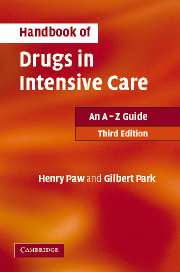DRUGS: An A-Z Guide
Published online by Cambridge University Press: 06 December 2010
Summary
Acetazolamide is a carbonic anhydrase inhibitor normally used to reduce intra-ocular pressure in glaucoma. Metabolic alkalosis may be partially corrected by the use of acetazolamide. The most common cause of metabolic alkalosis on the ICU is usually the result of furosemide administration.
Uses
Metabolic alkalosis (unlicensed)
Contraindications
Hypokalaemia
Hyponatraemia
Hyperchloraemic acidosis
Severe liver failure
Renal failure
Sulphonamide hypersensitivity
Administration
IV: 250500 mg, given over 35 min every 8 hours
Reconstitute with 5 ml WFI
Monitor: FBC, U&E and acid/base balance
How not to use acetazolamide
IM injection – painful
Not for prolonged use
Adverse effects
Metabolic acidosis
Electrolyte disturbances (hypokalaemia and hyponatraemia)
Blood disorders
Abnormal LFT
Cautions
Avoid extravasation at injection site (risk of necrosis)
Avoid prolonged use (risk of adverse effects)
Concurrent use with phenytoin (↑ serum level of phenytoin)
Organ failure
Renal: avoid (metabolic acidosis) Hepatic: avoid (abnormal LFT)
ACETYLCYSTEINE (Parvolex)
Acetylcysteine is an effective antidote to paracetamol if administered within 8 h after an overdose. Although the protective effect diminishes progressively as the overdose – treatment interval increases, acetylcysteine can still be of benefit up to 24 h after the overdose. In paracetamol overdose the hepatotoxicity is due to formation of a toxic metabolite. Hepatic reduced glutathione inactivates the toxic metabolite by conjugation, but glutathione stores are depleted with hepatotoxic doses of paracetamol. Acetylcysteine, being a sulphydryl (SH) group donor, protects the liver probably by restoring depleted hepatic reduced glutathione or by acting as an alternative substrate for the toxic metabolite.
- Type
- Chapter
- Information
- Handbook of Drugs in Intensive CareAn A - Z Guide, pp. 1 - 186Publisher: Cambridge University PressPrint publication year: 2007



